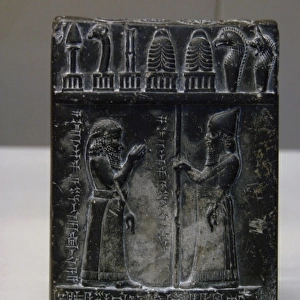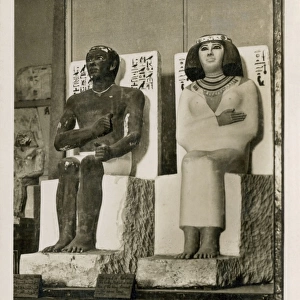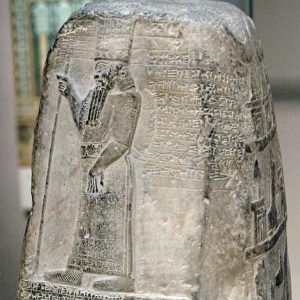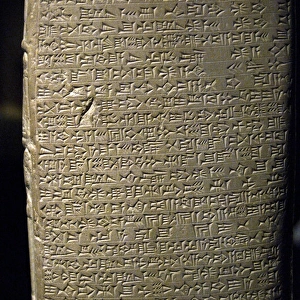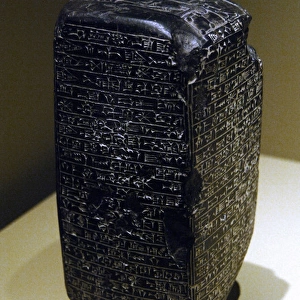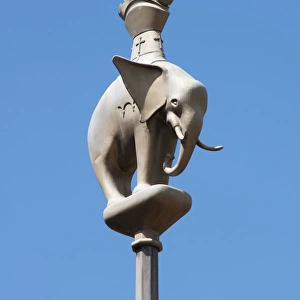Framed Print > Europe > United Kingdom > England > London > Museums > British Museum
Framed Print : Mesopotamian Art. Alabaster flower vase shaped as a woman ho
![]()

Framed Photos from Mary Evans Picture Library
Mesopotamian Art. Alabaster flower vase shaped as a woman ho
Mesopotamian Art. Alabaster flower vase shaped as a woman holding flowers. Dated between 700-600 B.C. It comes from Sippar. British Museum. London. England. United Kingdom
Mary Evans Picture Library makes available wonderful images created for people to enjoy over the centuries
Media ID 14378668
© Thaliastock / Mary Evans
Alabaster Curly Hold Mesopotamia Mesopotamian Sculpted Vase
A2 Premium Frame with A3 Poster
Transform your home decor with our exquisite Framed Prints from the Media Storehouse collection. Feast your eyes on this stunning Mesopotamian masterpiece, featuring an intricately carved alabaster flower vase from around 700-600 B.C. This ancient artifact, sourced from Sippar and now housed in the British Museum in London, England, depicts a woman gracefully holding flowers. Add a touch of ancient history and timeless beauty to your space with our high-quality framed prints. Each print is carefully preserved and beautifully presented in a sleek, modern frame, ensuring a stunning visual impact. Elevate your interior design with a piece of history that will captivate and inspire.
Premium Paradise Wooden Range A2 Premium Poster Frame (62x45cm) with A3 Poster (42x30cm) and mounted behind a white matt board to make your photo really stand out. FSC Certified and Rainforest Alliance Certified for environmental, social, and economic sustainably. High transparency tempered glass window with a smooth finished frame. Great for filling empty walls, decorating blank spaces, or creating eye-catching gallery walls. Frames arrive ready to hang. Sent with secure, protective packaging. Smooth wooden veneer mimics the real wood look and feel with ultra-durable scratch resistance tempered glass.
Contemporary Framed and Mounted Prints - Professionally Made and Ready to Hang
Estimated Image Size (if not cropped) is 40.4cm x 40.4cm (15.9" x 15.9")
Estimated Product Size is 44.6cm x 62cm (17.6" x 24.4")
These are individually made so all sizes are approximate
Artwork printed orientated as per the preview above, with landscape (horizontal) or portrait (vertical) orientation to match the source image.
FEATURES IN THESE COLLECTIONS
> Europe
> United Kingdom
> England
> London
> Museums
> British Museum
> Europe
> United Kingdom
> England
> London
> Related Images
> Europe
> United Kingdom
> England
> London
> Sights
> British Museum
> Europe
> United Kingdom
> England
> Posters
> Europe
> United Kingdom
> England
> Related Images
> Europe
> United Kingdom
> England
> Sculptures
> Europe
> United Kingdom
> Related Images
> Historic
> Ancient civilizations
> Mesopotamia
> Ancient Mesopotamian art
EDITORS COMMENTS
This exquisite Mesopotamian artifact, a flower vase shaped as a woman holding flowers, showcases the exceptional craftsmanship and artistic prowess of ancient civilizations. Dated between the 7th and 6th centuries BC, this masterpiece originated from the ancient city of Sippar, located in modern-day Iraq, which was part of the Mesopotamian civilization. The vase is made of alabaster, a prized material for sculpting due to its smooth surface and translucent quality. The woman depicted in the vase is sculpted with intricate details, her curly hair cascading down her shoulders, and her body gracefully holding a bouquet of flowers. The delicate petals of the flowers are expertly carved, adding to the overall beauty and elegance of the piece. Mesopotamian art is known for its intricate designs and symbolic representations, and this vase is no exception. The woman's form is not only an aesthetic pleasure but also holds symbolic meaning. The vase may have been used for religious or ceremonial purposes, with the woman representing fertility and the flowers symbolizing rebirth and renewal. This precious relic now resides in the British Museum in London, England, United Kingdom, where it continues to captivate and inspire visitors from around the world. The intricacies of the carving, the beauty of the alabaster material, and the historical significance of the piece make it a must-see for anyone interested in ancient history and art.
MADE IN AUSTRALIA
Safe Shipping with 30 Day Money Back Guarantee
FREE PERSONALISATION*
We are proud to offer a range of customisation features including Personalised Captions, Color Filters and Picture Zoom Tools
SECURE PAYMENTS
We happily accept a wide range of payment options so you can pay for the things you need in the way that is most convenient for you
* Options may vary by product and licensing agreement. Zoomed Pictures can be adjusted in the Cart.





